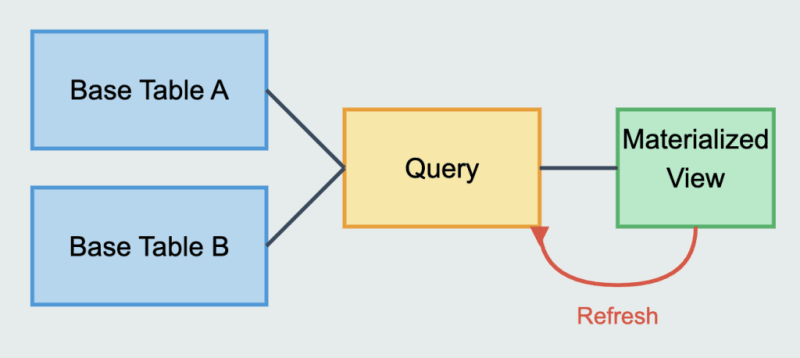MySQL 物化视图综合指南
MySQL 中的物化视图:可以做到吗?
物化视图是数据库管理中的一项重要功能,可以显着提高查询性能和数据检索效率。虽然 MySQL 不像其他一些数据库系统那样本身支持物化视图,但有一些有效的解决方法可以实现类似的功能。本文深入探讨了什么是物化视图、它们的优点以及如何在 MySQL 中实现它们。
什么是物化视图?
物化视图是包含查询结果的数据库对象。与每次查询时动态生成结果的标准视图不同,物化视图物理存储查询结果数据,从而提高复杂和资源密集型查询的性能。
物化视图的主要优点
- 物化视图存储查询结果,减少重复执行复杂查询的需要。
- 它们允许更快的数据检索,这对于大型数据集和实时应用程序至关重要。
- 通过缓存查询结果,物化视图减少了数据库服务器的负载。
让我们用这个图来解释物化视图的概念:

- 基表:在图的左侧,我们有两个矩形,标记为“基表 A”和“基表 B”。这些代表包含原始数据的原始数据库表。
- 查询:在中间,我们有一个标记为“查询”的矩形。这表示在基表上执行的查询或一组操作以派生特定结果集。
- 物化视图:在右侧,我们有一个标记为“物化视图”的矩形。这是我们正在说明的关键概念。
物化视图是包含查询结果的数据库对象。与每次访问时运行查询的常规视图不同,物化视图像表一样物理存储结果集。这有几个优点:
- 性能:对于复杂查询,尤其是涉及大型数据集或多个联接的查询,物化视图可以显着提高查询性能,因为结果是预先计算的。
- 数据仓库和 OLAP:它们在数据仓库和 OLAP(在线分析处理)场景中特别有用,在这些场景中,您可能会进行复杂的聚合或计算,而即时计算的成本很高。
- 箭头:图中的箭头显示了数据的流动。从基表到查询的箭头表示正在处理的原始数据。从查询到物化视图的箭头表示正在存储的结果。
- 刷新:底部标有“刷新”的弯曲箭头是理解物化视图的关键部分。由于基表中的数据可能会随着时间的推移而变化,因此需要定期更新或“刷新”物化视图以反映这些变化。此刷新可以设置为按特定时间间隔自动发生,也可以在需要时手动完成。
物化视图需要在查询性能和数据新鲜度之间进行权衡。它们提供快速的查询结果,但代价是刷新之间可能会出现稍微过时的数据。
在 MySQL 中实现物化视图
虽然MySQL本身不支持物化视图,但您可以使用表和触发器的组合来实现它们。以下是有关如何在 MySQL 中创建物化视图的分步指南:
第 1 步:创建基表
首先,创建一个用于存储物化视图数据的基表。
<span>CREATE TABLE materialized_view AS</span><br> <span>SELECT column1, column2, aggregate_function(column3)</span><br> <span>FROM base_table</span><br> <span>GROUP BY column1, column2;</span>
第 2 步:设置触发器来维护物化视图
为了确保物化视图与基表保持同步,您需要为 INSERT、UPDATE 和 DELETE 操作创建触发器。
插入触发器
<span>CREATE TRIGGER trg_after_insert AFTER INSERT ON base_table</span><br> <span>FOR EACH ROW</span><br> <span>BEGIN</span><br> <span> INSERT INTO materialized_view (column1, column2, column3)</span><br> <span> VALUES (NEW.column1, NEW.column2, NEW.column3);</span><br> <span>END;</span>
更新触发器
<span>CREATE TRIGGER trg_after_update AFTER UPDATE ON base_table</span><br> <span>FOR EACH ROW</span><br> <span>BEGIN</span><br> <span> UPDATE materialized_view</span><br> <span> SET column1 = NEW.column1, column2 = NEW.column2, column3 = NEW.column3</span><br> <span> WHERE id = OLD.id;</span><br> <span>END;</span>
删除触发器
<span>CREATE TRIGGER trg_after_delete AFTER DELETE ON base_table</span><br> <span>FOR EACH ROW</span><br> <span>BEGIN</span><br> <span> DELETE FROM materialized_view WHERE id = OLD.id;</span><br> <span>END;</span>
第 3 步:刷新物化视图
根据应用程序的要求,您可能需要定期刷新物化视图以确保它反映最新的数据。这可以使用计划的事件或 cron 作业来完成。
预定活动示例
<span>CREATE EVENT refresh_materialized_view</span><br> <span>ON SCHEDULE EVERY 1 HOUR</span><br> <span>DO</span><br> <span>BEGIN</span><br> <span> TRUNCATE TABLE materialized_view;</span><br> <span> INSERT INTO materialized_view (column1, column2, aggregate_function(column3))</span><br> <span> SELECT column1, column2, aggregate_function(column3)</span><br> <span> FROM base_table</span><br> <span> GROUP BY column1, column2;</span><br> <span>END;</span>
使用快速数据库生成器的物化视图
虽然理解 SQL 和执行高效查询至关重要,但构建完整的数据库需要大量的 SQL 知识。这就是像 Five 这样的快速数据库构建器发挥作用的地方。
In Five, you can define your database schema using MySQL, including advanced operations. Five provides a MySQL database for your application and generates an automatic UI, making it easier to interact with your data.
With Five, you can create forms, charts, and reports based on your database schema. This means you can build interfaces that interact with data fields.
For example, if you have a complex query that aggregates data from multiple tables, you can create a materialized view to store the results of this query. This can significantly speed up your application by reducing the load on your database and providing quicker access to frequently queried data:
Five also allows you to write custom JavaScript and TypeScript functions, giving you the flexibility to implement complex business logic. This is crucial for applications that require more than just standard CRUD (Create, Read, Update, Delete) operations.
Once your application is built, you can deploy your application to a secure, scalable cloud infrastructure with just a few clicks. This allows you to focus on development without worrying about the complexities of cloud deployment.
If you are serious about working with MySQL give Five a try. Sign up for free access to Five’s online development environment and start building your web application today.
<strong>Build Your Database In 3 Steps</strong><br><span>Start Developing Today</span>
Get Instant Access

Considerations For Materialized Views in MySQL
- Storage: Materialized views consume additional storage space. Ensure that your database has adequate space to accommodate the materialized views.
- Maintenance: Regularly maintain and refresh materialized views to ensure data consistency and accuracy.
- Indexing: Use appropriate indexing on materialized view tables to further enhance query performance.
Conclusion
Although MySQL does not support them natively, you can effectively implement materialized views using tables and triggers. By understanding and utilizing materialized views, you can significantly enhance the performance and scalability of your MySQL database applications.
FAQs
Q: Does MySQL support materialized views natively?
No, MySQL does not support materialized views natively, but you can achieve similar functionality using tables and triggers.
Q: How often should I refresh my materialized view?
The refresh frequency depends on your application’s requirements. For real-time applications, you might need more frequent updates, while less frequent updates might suffice for batch processing applications.
Q: What are the alternatives to materialized views in MySQL?
Alternatives include using temporary tables, cache tables, or optimizing queries through indexing and query restructuring.
以上是MySQL 物化视图综合指南的详细内容。更多信息请关注PHP中文网其他相关文章!

热AI工具

Undresser.AI Undress
人工智能驱动的应用程序,用于创建逼真的裸体照片

AI Clothes Remover
用于从照片中去除衣服的在线人工智能工具。

Undress AI Tool
免费脱衣服图片

Clothoff.io
AI脱衣机

Video Face Swap
使用我们完全免费的人工智能换脸工具轻松在任何视频中换脸!

热门文章

热工具

记事本++7.3.1
好用且免费的代码编辑器

SublimeText3汉化版
中文版,非常好用

禅工作室 13.0.1
功能强大的PHP集成开发环境

Dreamweaver CS6
视觉化网页开发工具

SublimeText3 Mac版
神级代码编辑软件(SublimeText3)
 MySQL的角色:Web应用程序中的数据库
Apr 17, 2025 am 12:23 AM
MySQL的角色:Web应用程序中的数据库
Apr 17, 2025 am 12:23 AM
MySQL在Web应用中的主要作用是存储和管理数据。1.MySQL高效处理用户信息、产品目录和交易记录等数据。2.通过SQL查询,开发者能从数据库提取信息生成动态内容。3.MySQL基于客户端-服务器模型工作,确保查询速度可接受。
 说明InnoDB重做日志和撤消日志的作用。
Apr 15, 2025 am 12:16 AM
说明InnoDB重做日志和撤消日志的作用。
Apr 15, 2025 am 12:16 AM
InnoDB使用redologs和undologs确保数据一致性和可靠性。1.redologs记录数据页修改,确保崩溃恢复和事务持久性。2.undologs记录数据原始值,支持事务回滚和MVCC。
 MySQL与其他编程语言:一种比较
Apr 19, 2025 am 12:22 AM
MySQL与其他编程语言:一种比较
Apr 19, 2025 am 12:22 AM
MySQL与其他编程语言相比,主要用于存储和管理数据,而其他语言如Python、Java、C 则用于逻辑处理和应用开发。 MySQL以其高性能、可扩展性和跨平台支持着称,适合数据管理需求,而其他语言在各自领域如数据分析、企业应用和系统编程中各有优势。
 初学者的MySQL:开始数据库管理
Apr 18, 2025 am 12:10 AM
初学者的MySQL:开始数据库管理
Apr 18, 2025 am 12:10 AM
MySQL的基本操作包括创建数据库、表格,及使用SQL进行数据的CRUD操作。1.创建数据库:CREATEDATABASEmy_first_db;2.创建表格:CREATETABLEbooks(idINTAUTO_INCREMENTPRIMARYKEY,titleVARCHAR(100)NOTNULL,authorVARCHAR(100)NOTNULL,published_yearINT);3.插入数据:INSERTINTObooks(title,author,published_year)VA
 MySQL与其他数据库:比较选项
Apr 15, 2025 am 12:08 AM
MySQL与其他数据库:比较选项
Apr 15, 2025 am 12:08 AM
MySQL适合Web应用和内容管理系统,因其开源、高性能和易用性而受欢迎。1)与PostgreSQL相比,MySQL在简单查询和高并发读操作上表现更好。2)相较Oracle,MySQL因开源和低成本更受中小企业青睐。3)对比MicrosoftSQLServer,MySQL更适合跨平台应用。4)与MongoDB不同,MySQL更适用于结构化数据和事务处理。
 解释InnoDB缓冲池及其对性能的重要性。
Apr 19, 2025 am 12:24 AM
解释InnoDB缓冲池及其对性能的重要性。
Apr 19, 2025 am 12:24 AM
InnoDBBufferPool通过缓存数据和索引页来减少磁盘I/O,提升数据库性能。其工作原理包括:1.数据读取:从BufferPool中读取数据;2.数据写入:修改数据后写入BufferPool并定期刷新到磁盘;3.缓存管理:使用LRU算法管理缓存页;4.预读机制:提前加载相邻数据页。通过调整BufferPool大小和使用多个实例,可以优化数据库性能。
 MySQL:结构化数据和关系数据库
Apr 18, 2025 am 12:22 AM
MySQL:结构化数据和关系数据库
Apr 18, 2025 am 12:22 AM
MySQL通过表结构和SQL查询高效管理结构化数据,并通过外键实现表间关系。1.创建表时定义数据格式和类型。2.使用外键建立表间关系。3.通过索引和查询优化提高性能。4.定期备份和监控数据库确保数据安全和性能优化。
 学习MySQL:新用户的分步指南
Apr 19, 2025 am 12:19 AM
学习MySQL:新用户的分步指南
Apr 19, 2025 am 12:19 AM
MySQL值得学习,因为它是强大的开源数据库管理系统,适用于数据存储、管理和分析。1)MySQL是关系型数据库,使用SQL操作数据,适合结构化数据管理。2)SQL语言是与MySQL交互的关键,支持CRUD操作。3)MySQL的工作原理包括客户端/服务器架构、存储引擎和查询优化器。4)基本用法包括创建数据库和表,高级用法涉及使用JOIN连接表。5)常见错误包括语法错误和权限问题,调试技巧包括检查语法和使用EXPLAIN命令。6)性能优化涉及使用索引、优化SQL语句和定期维护数据库。






